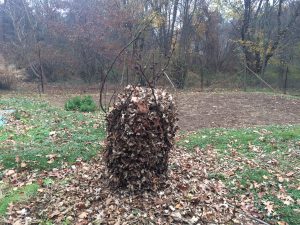Every year the Delaware Nursery and Landscape Association selects an herbaceous plant (usually a perennial that dies back to the ground each winter) and a woody plant (usually a tree or a shrub) to designate as Plants of the Year. Plants are selected that will thrive in Delaware’s conditions and that have few disease and insect problems. If sited properly, these plants are guaranteed to succeed. These plants are often underused in the Delaware landscape. So, if you purchase one of these plants, you will be a trendsetter in your neighborhood. The 2017 selections were just announced at the Delaware Horticulture Industry Expo in Dover.
Schizachyrium scoparium ‘Standing Ovation’
‘Standing Ovation’ little bluestem is a warm season grass with blue-green spikey stems and leaves. Leaves have a purplish caste at the base. Fluffy, light-catching seed clusters appear in late summer/fall. In fall, little bluestem turns an apricot color that brightens the winter landscape. ‘Standing Ovation’ has sturdy blades that are thicker than most bluestems, remaining sturdy even in richer garden soils. ‘Standing Ovation’ with its sturdy habit and excellent fall color makes a good accent or mass planting in a perennial or shrub border. Cut back in early spring to make room for new emerging leaves. Little bluestem is a great addition to a meadow. If you are managing a meadow and want to add some interest, buy a few ‘Standing Ovation’ little bluestems to spark up your meadow. They can also be planted in a garden bed, but be careful about rick soil. While ‘Standing Ovation’ can tolerate garden soils, most little bluestems do best in sterile, non-organic soils (i.e. the kind we have throughout Delaware if we aren’t working hard to improve the soil).

‘Standing Ovation’ little bluestem looks fantastic throughout the year. Photo credit: North Creek Nurseries
Taxodium distichum
Bald cypress is a pyramidal, deciduous conifer that grows 50-70 feet tall. It thrives in average to wet soils, preferring sandy soils, but tolerating anything from dry conditions to standing water. Trunks are buttressed at the base, often developing knobby root growths, called knees, when grown in water. Soft, yellow-green needles turn an attractive orange/cinnamon-brown in fall. Purplish green cones mature to brown. Bald cypress is a striking specimen tree for a variety of large areas since it tolerates a wide range of conditions. You can see lots of bald cypress in Trap Pond State Park in Laurel, Delaware. You can canoe or take a pontoon boat out into the water to see the most northern natural collection of bald cypress trees. Remember, these trees are deciduous, meaning they lose their leaves in the fall. So, don’t get out the chain saw when the needles begin to drop. They are conifers and most conifers are evergreen so you would not be the first person to think the tree had died.
Visit a garden center in Delaware this spring and pick up one or more of these great plants for your garden!




